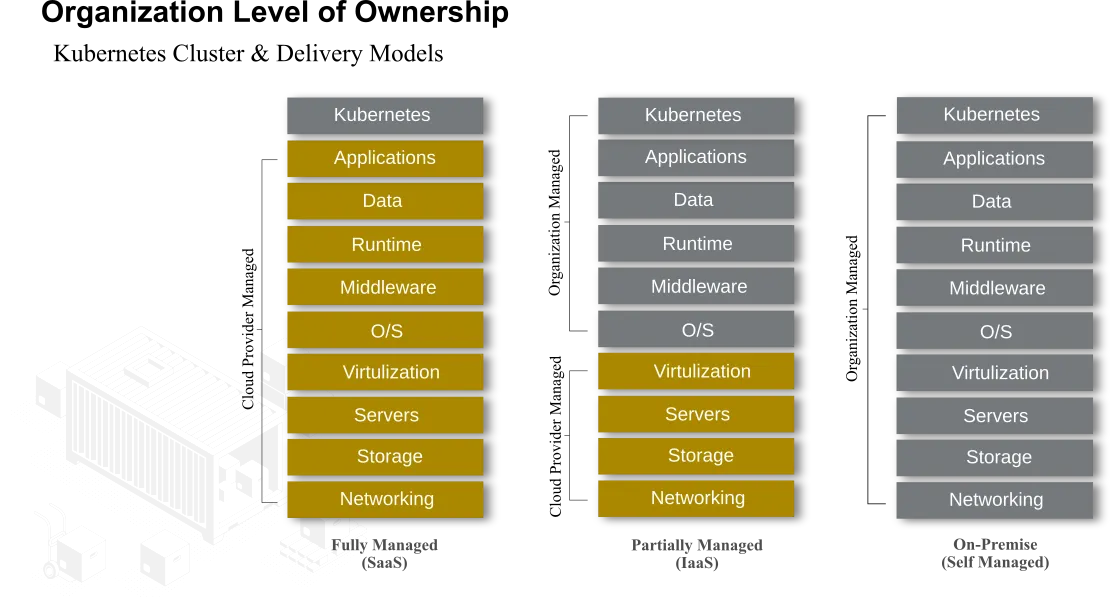Navigating the Kubernetes Landscape: Making the Right Choice for Your Organization

Organizations still weighing whether to adopt Kubernetes for managing and orchestrating their applications face a consequential decision that will impact their operational efficiency and bottom line. While Kubernetes has become the industry standard for container orchestration, choosing the right implementation approach requires careful consideration.
In this guide, I'll walk you through the different Kubernetes delivery models—managed, partially-managed, and self-managed—highlighting their distinct advantages, potential drawbacks, and critical budget implications. By understanding these nuances, you'll be better positioned to select the solution that best aligns with your organization's growth trajectory and development goals.
Whether you're a CTO making a strategic decision, a DevOps engineer evaluating implementation options, or an IT manager concerned about resource allocation, this breakdown will help you chart the most efficient course through the Kubernetes ecosystem.
The Rise of Kubernetes
It has been a little over ten years since Kubernetes made its debut, and the container orchestration platform has transformed how we think about application deployment. While many organizations have already migrated their legacy applications from dedicated servers to Kubernetes clusters, others are still weighing their options.
Before diving headfirst into Kubernetes, organizations should consider several crucial factors: the variety of Kubernetes solutions available, how each delivery model impacts operations, and the often-overlooked budget implications that can make or break your implementation strategy.
What Exactly Is Kubernetes?
The name "Kubernetes" comes from Ancient Greek, meaning "helmsman" or "steersman" – quite fitting for a technology that navigates the complex waters of container orchestration. In today's tech landscape, Kubernetes has become practically synonymous with container management.
Kubernetes is an open source platform for automating deployment, scaling, and management of containerized applications.
Remember the old days? Standing up an application with multiple services could take days of tedious work. One would need to prepare virtual machines for each service, configure intricate details and integrations, set up networking, implement security measures, and handle service-specific configurations. It was like building a ship one painstaking plank at a time.
Fast forward to today, and Kubernetes has changed everything. That same multi-service application can now be deployed within hours – sometimes even minutes. Better yet, you gain unprecedented flexibility in management, enhanced observability, and granular control over your computing resources. It's like upgrading from a rowboat to a modern vessel with GPS, radar, and an experienced crew.
Your Kubernetes Options: Choosing the Right Path
The question isn't whether to adopt Kubernetes – in today's competitive landscape, it's become essential. The real decision is how to implement it. Organizations looking to migrate to Kubernetes have three main routes: managed clusters, partially-managed clusters, or self-managed clusters.

Managed Kubernetes: The Full-Service Experience
Opting for Managed Kubernetes (or Kubernetes-as-a-Service/KaaS) means choosing solutions like AKS (Microsoft), EKS (Amazon), GKE (Google), or ROSA (Red Hat OpenShift on AWS). These offerings follow the Software-as-a-Service (SaaS) model.
The core appeal? You offload infrastructure and OS maintenance to your cloud provider, allowing your team to focus exclusively on developing microservices and managing the Kubernetes platform itself. It's like hiring an experienced crew to handle the ship's engine room while you concentrate on navigation and destination.
These managed solutions enable organizations to quickly harness Kubernetes power with relatively painless onboarding. However, if your organization needs cutting-edge technology or custom runtime environments, you might find these managed solutions somewhat limiting.
One aspect often overlooked is the budget impact. Traditional on-premise solutions typically fall under Capital Expenditure (CapEx), while shifting to a cloud provider moves these costs to Operating Expenditure (OpEx). This financial restructuring can have significant implications for your organization's budgeting approach.
Partially-Managed Kubernetes: Finding the Balance
A partially-managed solution leverages the Infrastructure-as-a-Service (IaaS) model, creating a shared responsibility for your Kubernetes platform while preserving the freedom to customize your implementation.
This approach involves leasing infrastructure from a cloud provider on a metered, subscription basis. The provider maintains the underlying infrastructure, ensuring uptime according to their service terms, while you maintain control over the Kubernetes layer.
This model gives organizations the flexibility to design and deploy custom Kubernetes platforms, opening doors to specialized solutions like custom runtime environments, cutting-edge hardware integration, and support for niche use cases. You're essentially chartering a vessel but bringing your own navigation equipment and crew.
While this approach frees you from infrastructure maintenance headaches, it does require more hands-on management than fully managed solutions.
On-Premise Kubernetes: Complete Control
The self-managed approach involves leveraging your own on-premise infrastructure to build and maintain your Kubernetes cluster. This gives you maximum control but also comes with the highest management overhead.
While an on-premise Kubernetes solution provides organizations with the greatest leeway around building out their Kubernetes platform, this approach requires that the organization be responsible for power, networking, infrastructure, maintenance and upkeep of all components needed to operate a Kubernetes platform.
As far as budgeting, an on-premise solution requires a significant investment in both CapEx and OpEx, with upfront costs for hardware and ongoing expenses for maintenance, power, cooling, and personnel.
Making the Right Decision
When choosing between these options, consider these key factors:
- Maintenance and administrative requirements: How much overhead can your organization handle?
- Your team's technical expertise and bandwidth: Do you have the right skills in-house?
- Desired total cost of ownership: Are you optimizing for short-term or long-term costs?
- Specific application requirements: Do you need custom container runtimes, specialized networking, or proprietary storage solutions?
While advanced designs like hybrid clusters (combining on-premise and data center resources) and highly-available architectures (multiple clusters functioning as one) offer additional options, the fundamental choice between managed, partially-managed, and self-managed Kubernetes will form the foundation of your container strategy.
Conclusion: Chart Your Course Wisely
The right choice depends entirely on your organization's unique needs, resources, and goals. By carefully weighing these factors, you'll be well-positioned to navigate the Kubernetes seas confidently and successfully.
Remember that your Kubernetes journey doesn't end with deployment. Like any good captain, you'll need to continuously monitor, adjust, and optimize your approach as both your organization and the technology landscape evolve.




